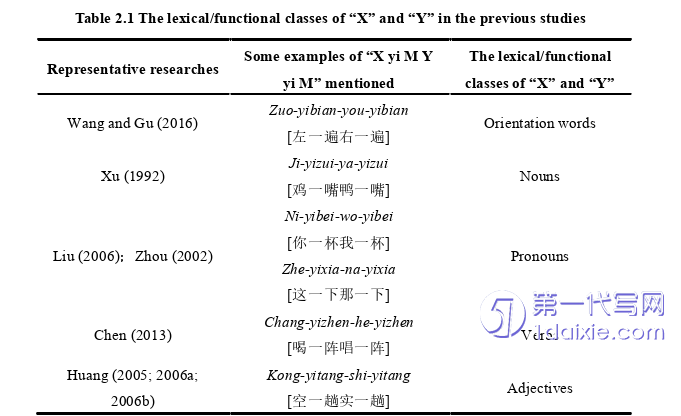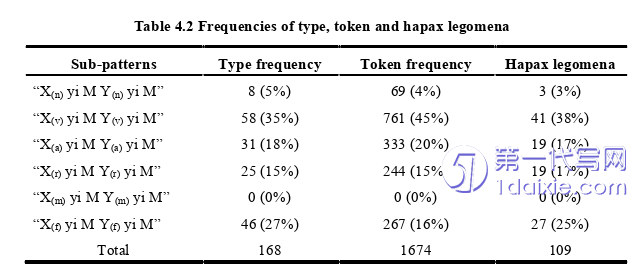本文是一篇英语论文,本研究具有一定的理论意义和实践价值:第一,本研究补充和完善了对举构式“X一量Y一量”的句法语义特征的研究,尤其是对其构式义的研究;第二,基于构式形成的认知动因并借助“三域”理论来阐释构式的语义范畴这种分析思路可以为多义性构式研究提供借鉴;
Chapter One Introduction
1.1 Research Subject
The linguistic phenomenon, to which this study pays attention, is instantiated by the expressions underlined in the following examples (Throughout the thesis, if there is no special note attached to an example, it means that the example is taken from the BCC corpus.).
(1) 待她收工回家一看,孩子常常哭得泪一把鼻涕一把。
When she finish work go home look, children always cry tear-one handful-mucus-one handful. ‘When she came home from work, the children were always crying and sniveling.’
(2) 想到还要到墓地,便立刻深一脚浅一脚前往,雪深路远,茫茫雪野中似乎难辨方向。
Think still need to go to cemetery, immediately deep-one step-shallow-one step, snow deep way long, in vast snow field seem difficult tell direction. ‘Thinking of that (he) still needed to go to the cemetery, (he) immediately stumbled forward. The snow was deep and it was a long way. It seemed difficult to tell the direction in the vast snow field.’
One common feature shared by lei-yiba-biti-yiba ‘crying and sniveling’, and shen-yijiao-qian-yijiao ‘stumble’ in the two examples above is that both of them can be broken up into two parts, or to put it another way, both of them are formed by merging two parts. Lei-yiba-biti-yiba consists of lei-yiba and biti-yiba and shen-yijiao-qian-yijiao of shen-yijiao and qian-yijiao. What is constant for the two parts is the quantitative phrase, made up of the numeral “yi” and a measure word. In this study, the quantitative phrase is codified as “yi M” and the two parts as “X yi M” and “Y yi M” respectively. Such linguistic expressions as the two examples, in turn, are codified as “X yi M Y yi M”.
1.2 Research Background
The symmetry construction “X yi M Y yi M” in modern Chinese has been described and explained from different perspectives. Its syntactic features, semantic features, and pragmatic functions have been discussed by the previous studies. Additionally, the previous studies have tried to interpret it from a cognitive perspective. Nonetheless, the existing studies are not free of limitations and controversies.
Further discussions on the syntactic features of the modern Chinese symmetry construction “X yi M Y yi M” are necessary. The classification of the symmetry construction provided by the previous studies are not detailed enough. Besides, the ordering problem of the internal constituents of the symmetry construction is not fully solved by the previous studies; more specifically, the structural constraints or the claimed ordering preferences on the internal components of the symmetry construction “X yi M Y yi M” are concluded on the basis of observing limited or random language phenomena. There is a need for robust evidence to reduce controversy as well as to support the conclusions regarding the ordering problem.
Chapter Two Literature Review
2.1 The Syntactic Features of the Symmetry Construction
The precious studies on the syntactic features of the symmetry construction “X yi M Y yi M” can be divided into the syntactic features of its internal constituents, those of the construction as a whole and the internal ordering of the construction.
2.1.1 The Syntactic Features of the Internal Constituents
The syntactic features of the internal constituents of the symmetry construction “X yi M Y yi M” discussed in the previous studies are organized as follows: the syntactic features of the elements in the X-slot and Y-slot, those of the measure words and some other syntactic features concerning the components.
The syntactic features of “X” and “Y”
In the previous studies on the symmetry construction “X yi M Y yi M”, it has been mentioned that “X” and “Y” can be two orientation words3, two nouns, two pronouns4, two verbs, or two adjectives, as shown by Table 2.1.

2.2 The Semantic Features of the Symmetry Construction
The previous studies on the semantic features of the modern Chinese symmetry construction “X yi M Y yi M” can be divided into the semantic features of the internal constituents and the meanings that can be expressed by the construction as a whole.
2.2.1 The Semantic Features of the Internal Constituents
The semantic features of the internal constituents of the symmetry construction discussed in the previous studies include the semantic features of the elements at the X-slot and Y-slot and those of “yi M”.
The semantic features of “X” and “Y”
It has been agreed upon, by many previous studies (Liu, 1982; Xu, 1992; Yin, 1995; Lü, 1998 etc.), that the semantics of the elements at the X-slot and Y-slot in the symmetry construction “X yi M Y yi M” displays vagueness in terms of their reference. The original meanings of the elements at the two slots are weakened in this construction. Besides, the previous studies have summarized the semantic relationship between “X” and “Y”. Lingmu (2008) claimed that there is usually an antonymous or synonymous relationship between the semantics of “X” and “Y”. However, this summary is not comprehensive enough. As other studies (e.g., Zhou, 2002; Yin, 2004; Zi, 2005) pointed out, “X” and “Y” in the symmetry construction “X yi M Y yi M” can also be a pair of words which denote sameness, that is, they can be organized into a certain category. For example, the two elements at the X-slot and Y-slot in hong-yikuai-bai-yikuai [红一块白一块] are neither antonymous nor synonymous. Both of them are from the color category.
Chapter Three Theoretical Foundation ................................... 30
3.1 Construction Grammar ....................................... 30
3.2 The Symmetric Iconicity of Language ...................... 33
Chapter Four The Formal Features and Polysemy of the Symmetry Construction ......... 42
4.1 The Formal Features of the Symmetry Construction .......................... 43
4.1.1 The Sub-patterns of the Symmetry Construction .......................... 44
4.1.2 The Ordering of “X”, “Y” and “yi M” .................. 51
Chapter Five The Cognitive Motivation and Mechanism .............................. 64
5.1 The Cognitive Motivation for the Formation of the Symmetry Construction ...... 65
5.1.1 The Symmetric Iconicity and the Symmetry Construction ......................... 65
5.1.2 The Central Meanings of the Symmetry Construction ................................ 68
Chapter Five The Cognitive Motivation and Mechanism
5.1 The Cognitive Motivation for the Formation of the Symmetry Construction
In this section, the cognitive motivation for the formation of the symmetry construction “X yi M Y yi M” will be discussed first by referring to the symmetric iconicity of language. Additionally, Goldberg (1995) mentioned that the polysemous constructions can have a central meaning. After interpreting the reason for the formation of the construction, the central meanings of the construction can be determined.
5.1.1 The Symmetric Iconicity and the Symmetry Construction
Iconicity describes the relation between language and the conceptual structure or the experiential structure of human beings. According to Haiman (1985a; 1985b), iconicity is the natural and internal relation between the linguistic structure and the experiential structure or conceptual structure, and it means that the former mirrors the latter. This interpretation of iconicity is in line with the second type of linguistic iconicity put forward by Haiman (1980). The two types of linguistic iconicity are “isomorphism” and “motivation”. The explanation of the former is that if the linguistic forms are similar, their meanings should resemble each other. The illustration of the latter is that there exists similarity between language structures that are diagrammatic and the conceptual structures signified by these language structures. The theoretical thought of iconicity has been applied to explicate a variety of linguistic structures or phenomena, such as Chinese contracted sentences (Zhou & Zhou, 2022), noun reduplications (Wang & Song, 2020), etc. It should not be denied that the iconicity of language has its own merits in terms of anatomizing linguistic forms.

Chapter Six Conclusion
6.1 Major Findings and Implications
This study pays attention to three research questions: (1) What are the meanings of the modern Chinese symmetry construction “X yi M Y yi M”? (2) What is the cognitive motivation for the formation of the modern Chinese symmetry construction “X yi M Y yi M”? (3) What is the cognitive mechanism of the polysemy of the modern Chinese symmetry construction “X yi M Y yi M”? At the same time, this study also pays attention to the weaknesses existing in the discussions on the formal features of this construction in the previous studies and makes corresponding supplements. The major research findings can be summarized as follows:
Firstly, complements have been made to the syntactic and semantic features of the symmetry construction “X yi M Y yi M”. The elements at the X-slot and Y-slot can be bare linguistic forms or in more complex linguistic forms. Due to the need to follow the symmetry of the construction, the elements that fill the two slots of a construct usually belong to the same lexical or functional category. This construction includes two parts and each part carries a measure word. The two measure words are usually the same, but they can also be different. According to the lexical or functional categories of the elements in the two open slots, this symmetry construction can be divided into 7 sub-patterns, “X(n) yi M Y(n) yi M”, “X(v) yi M Y(v) yi M”, “X(a) yi M Y(a) yi M”, “X(r) yi M Y(r) yi M”, “X(m) yi M Y(m) yi M”, “X(f) yi M Y(f) yi M”, and “X(o) yi M Y(o) yi M”, and each sub-pattern can be further divided into two cases: carrying the same measure word or two different measure words. Through observing the examples used in the previous studies and the data from the BCC corpus, it has been found that the symmetry construction carrying the same two measure words is more common. By doing statistical analysis, it has been demonstrated that “X(v) yi M Y(v) yi M” is the most productive one among the 7 sub-patterns. The ordering of the internal constituents of this construction, namely “X”, “Y” and “yi M”, is changeable. In other words, the symmetry construction “X yi M Y yi M” can be used as “Y yi M X yi M” or “yi M X yi M Y”. However, its internal order tends to be fixed when the construction includes antithetic marks or become idiomatic. It has also been revealed that the symmetry construction is polysemous and can express 6 constructional meanings, including alternation, simultaneity, dispersiveness, quantity, evaluation and sentiment.
reference(omitted)
